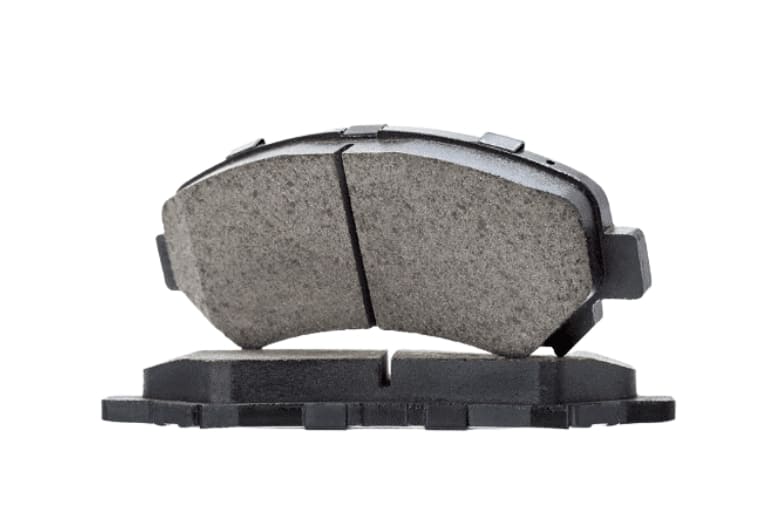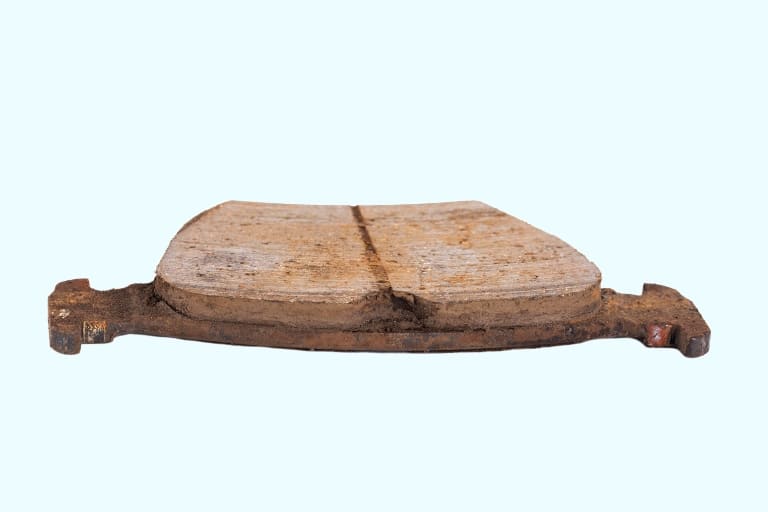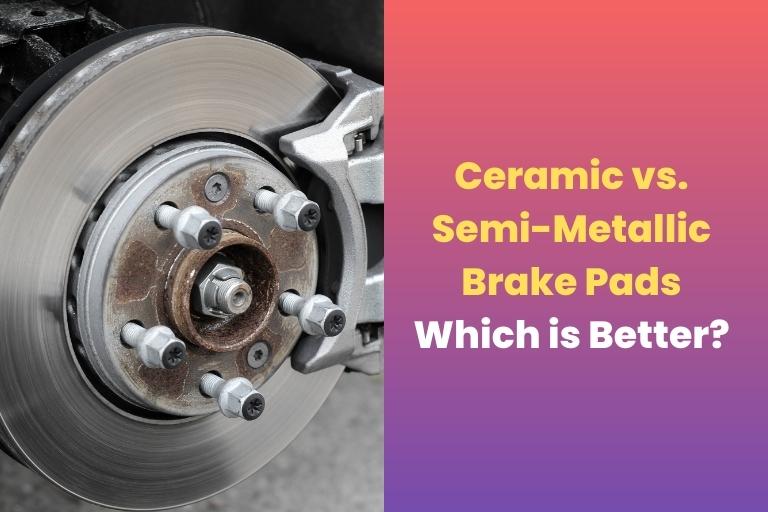Brake pads are critical to the safety and performance of our cars. You rely on these little but essential elements as automobile owners to bring your vehicles to a secure and regulated halt.
However, when it comes to selecting the correct brake pads for our car, the market provides a plethora of possibilities, each with its own set of benefits and drawbacks. Ceramic and semi-metallic brake pads are two standard options that are frequently at the core of the brake pad discussion. Both alternatives offer distinct features and promise to give improved braking performance.
In this article, we will delve into the world of braking systems and examine the critical differences between ceramic and semi-metallic brake pads. Let’s get into the article.
Contents
- 1 Ceramic vs. semi-metallic brake pads
- 1.1 Construction
- 1.2 The Function of Ceramic and Semi-Metallic Brake Pads
- 1.3 Noise Of Ceramic And Semi-Metallic Brake Pads
- 1.4 Dust Of Ceramic vs Semi-Metallic Brake Pads
- 1.5 Resistance to heat Comparison Between Ceramic and Semi-Metallic Brake pads
- 1.6 Longevity Comparison Between Ceramic and Semi-Metallic Brake pads
- 1.7 Cost of Ceramic and Semi-Metallic Brake Pads
- 1.8 Performance Comparison
- 1.9 Warranty
- 2 Comparison Table ceramic brake pads vs. semi-metallic brake pads
- 3 Advantages and disadvantages of ceramic and Semi-Metallic brake pads
- 4 Which is better Ceramic brake pads or semi-metallic brake pads?
- 5 Frequently Asked Questions
- 6 Conclusion
Ceramic vs. semi-metallic brake pads

Construction
Ceramic Brake Pads
Ceramic brake pads are constructed from a composite material that includes ceramic fibers, bonding agents, and fillers. The mixture is crushed under high pressure and then baked or sintered to cure it. For enhanced friction and heat transmission, copper fibers or powdered copper may be used. These fibers are reinforced with some amount of metal using a bonding agent to give them their structure. The design assures long-term endurance, heat dissipation, low noise, low dust, and consistent braking performance.
Semi-metallic Brake Pads
Semi-metallic brake pads are made from a combination of metal fibers, friction modifiers, fillers, and bonding agents. Metal fibers, which are frequently comprised of steel or copper, give strength and heat resistance. Under high pressure, the mixture is crushed and bound. This material enables better heat dissipation, braking performance, and durability. Semi-metallic brake pads are well known for their adaptability to various driving circumstances.
The Function of Ceramic and Semi-Metallic Brake Pads
Ceramic Brake Pads
Ceramic brake pads provide remarkable functionality owing to their unique design and materials. It employs ceramic composite materials and labor-saving roller structures to decrease brake wear. The brake life is five times that of standard vehicles. While the braking distance is reduced, 75% of the effort is saved.
Semi-metallic Brake Pads
Semi-metallic brake pads provide exceptional performance. They perform well in a wide variety of temperatures and circumstances, making them suited for regular journeys as well as track racing. Metallic brake pads quickly transfer heat, allowing them to withstand greater temperatures and help rapidly cool the braking system. They also demand less pedal pressure to stop effectively.
Noise Of Ceramic And Semi-Metallic Brake Pads
Ceramic brake pads
Ceramic brake pads make less noise than semi-metallic pads, resulting in a quieter operation.
Semi-metallic brake pads
Due to the metal composition, semi-metallic brake pads may produce more significant noise when braking. But the amount of noise produced solely depends upon the model of brake pads and your car.
Dust Of Ceramic vs Semi-Metallic Brake Pads

Ceramic brake pads
Ceramic brake pads are known to generate less brake dust than semi-metallic pads. This advantage keeps the wheels cleaner for extended periods of time, reducing the need for routine cleaning and maintenance.
Semi-Metallic Brake Pads
Semi-metallic brake pads produce more brake dust than ceramic pads. This might lead to dirtier wheels that require more regular cleaning to keep their look.
Resistance to heat Comparison Between Ceramic and Semi-Metallic Brake pads
Ceramic brake pads
Ceramic brake pads offer exceptional heat resistance and are appropriate for high-temperature applications.
Semi-metallic brake pads
Semi-metallic brake pads are also heat resistant. However, ceramic pads in harsh situations may work more effectively.
Longevity Comparison Between Ceramic and Semi-Metallic Brake pads
Ceramic brake pads
Since ceramic brake pads wear out more gradually than semi-metallic pads, they have a more prolonged lifespan.
Semi-metallic brake pads
Semi-metallic brake pads could wear more rapidly than ceramic pads precisely because of the presence of metal.
You May Also Like: How Long Do Brake Pads Last
Cost of Ceramic and Semi-Metallic Brake Pads
Ceramic brake pads
Ceramic brake pads are often more costly than semi-metallic brake pads.
Semi-metallic brake pads
Semi-Metallic brake pads are often less expensive than ceramic pads. This characteristic feature makes this more affordable and a prominent choice for many car drivers.
Performance Comparison
Ceramic brake pads
Ceramic brake pads provide consistent and smooth braking performance, especially in regular driving circumstances.
Semi-Metallic Brake Pads
Semi-metallic brake pads provide strong braking force and work well in high-stress conditions like towing or aggressive driving. The semi-metallic brake pads can also withstand unfavorable conditions.
Warranty
The warranty periods may differ depending on the manufacturer of the brake pads. It’s critical to compare the warranties provided by various companies for ceramic and semi-metallic brake pads.
Comparison Table ceramic brake pads vs. semi-metallic brake pads
| Factors | Ceramic Brake Pad | OEM Brake Pad |
| Noise | It is quieter | Produce more noise (may vary) |
| Dust | Less dust | More dust (may vary) |
| Heat Resistance | Excellent | Good |
| Longitivity | Longer Lifespan | Lesser lifespan (as compared to ceramic brake pads) |
| Cost | More expensive | Affordable |
| Performance | Outstanding: provides steady and smooth stopping power | Depends upon the usage and model of car |
| Warranty | Depends upon the brand | Depends upon the brand |
Advantages and disadvantages of ceramic and Semi-Metallic brake pads
Advantages and disadvantages of ceramic brake pads
| Advatages | Disadvantages |
| Quieter operation | Poor absorber of heat |
| Reduced brake dust | Highly expensive |
| Long lifespan | Do not function in extreme cold |
| Better stoping power | Do not work in towing situation |
| Stable under wide range of conditions | Might be hard on rotors (In rare cases) |
| Faster recovery after complete stop | Possible higher braking system temperatures due to less heat absorbency than other friction materials |
| Variety in particle sizes |
Advantages and Disadvantages of Semi-Metallic Brake Pads
| Advantage | Disadvantage |
| Provided strong braking power and performances | Produces more noise |
| Good heat dissipation | Produce more brake dust |
| Ideal for high-stress conditions | The rotor may wear and tear out easily |
| Effective against wide range of conditions | It is not as effective in extreme cold weather or climate |
| Affordable | Potential for increased pedal effort |
Which is better Ceramic brake pads or semi-metallic brake pads?
It is not sensible to recommend a specific brake pad because it entirely depends on your driving habits and preferences. Semi-metallic and ceramic brake pads’ performance, noise, and dust characteristics differ.
Semi-metallic brake pads provide more substantial stopping power and work better in high temperatures but generate more noise and debris. Ceramic brake pads are quieter and cleaner than metal brake pads but have less stopping power.
Semi-metallic brake pads are excellent for towing, truck driving, and performance automobiles, whereas ceramic brake pads are suitable for daily driving. Ceramic brake pads outlast metallic brake pads. However, both kinds are impacted by driving style.
Frequently Asked Questions
What lasts longer, metallic or ceramic brakes?
Ceramic brake pads. Ceramic brake pads are better for the environment, quieter, and emit less dust than metallic brake pads. They also have a longer lifespan and require less upkeep. They are, however, more expensive and may result in rotor damage.
Do semi-metallic brake pads squeal?
Yes. Semi-metallic brake pads are notorious for making an occasional squeaking noise. Squealing is a recognized concern with this type of pad if the pads are not consistent.
What are the two advantages of semi-metallic brake pads?
Semi-metallic pads are more heat resistant and gentler on rotors than ceramic pads. They are often less expensive and, where 60% metal is present, lend themselves to hard braking over a lengthy stretch of road or track.
You May Also Like to Read:
- How Close Should Brake Pads Be To Rotors?
- Can You Spray Brake Cleaner On Brake Pads? Does It Help?
- Can You Put Brake Pads On Backward? Why Should You Avoid?
- Brake Shudder After New Rotors And Pads? Here Is The Fix
- Are Brake Pads Interchangeable? Let’s Find Out
- Does The Emergency Brake Lock All Wheels?
- How Long Can You Drive On Grinding Brakes?
- Do Ceramic Brake Pads Contain Asbestos?
- Can You Use Front Brake Pads On The Rear?
- Why Does My Car Shake After Changing the Brake Pads?
- Should You Replace All 4 Brake Pads At Once?
- How to Install Anti-Rattle Clips on Brake Pads: Beginner’s Guide
- Driving Without Brake Pads: How Long is Safe?
- Ceramic vs OEM brake pads
- Ceramic vs Organic Brake Pads: In-depth Comparison
- Ceramic vs Carbon Fiber Brake Pads
Conclusion
In conclusion, the decision between ceramic and semi-metallic brake pads is ultimately determined by personal tastes and driving requirements.
Ceramic brake pads are quieter, create less brake dust, and are resistant to heat, making them suited for both regular driving and luxury automobiles. Semi-metallic brake pads, on the other hand, provide significant braking power, perform well in high-stress settings, and are less expensive.
They may, however, produce additional noise and brake dust. When picking between the two, considerations like as noise tolerance, intended performance, budget, and driving circumstances must all be considered. A competent technician may give tailored advice for the finest brake pad selection.
